The purpose of our article today is twofold. Our first mission is to give you, the consumer, some well deserved information on the features and results you can expect from the entire line of socket AM2 processors. Secondly, we’ll take a close look at the new socket AM2 X2 5000+ which along with its big brother the FX 62 sit atop the socket AM2 product line.
INTRODUCTION
During the past year AMD’s socket 939 line of FX, Athlon and Opteron processors in have gracefully emerged as champions in the Computer Enthusiast worlds most sacred race, speed. Some of the benchmarks have been close while others, namely gaming related, have been a runaway with AMD essentially allowing their closest competition to eat their dust while never looking back. As with any great champion, AMD was not satisfied with simply being in first place; but instead, remaining there indefinitely. Hence in lieu of sitting back on their haunches and gloating, work had already begun on their next generation of processor; the socket AM2.
For the past several months after the release of AMD’s latest processor road map, computer aficionados have been in a frenzy awaiting the release of AMD’s new socket AM2 processor. The speculation over just what features this new product line may bring to the table and more importantly deliver has been rampant. Rumors of vast performance increases coupled with architectural changes in the design of this new CPU were fervent amongst the masses at almost every enthusiast site on the Web.
Today, those so called rumors become fact and all myths will be dispelled. At 12:01 AM the import embargo on the socket AM2 chips patiently awaiting your scrutiny was lifted. The official launch date of June 1, 2006 still stands, even though many distributors and retailers should have this product available for sale as we speak.
The purpose of our article today is twofold. Our first mission is to give you, the consumer, some well deserved information on the features and results you can expect from the entire line of socket AM2 processors. Secondly, we’ll take a close look at the new socket AM2 X2 5000+ which along with its big brother the FX 62 sit atop the socket AM2 product line. Subsequent reviews at this site will cover the complete line of products that currently and in the future will be brought to market to complement and support this new processing behemoth.
SOCKET AM2 – AN OVERVIEW
Primary Differences
The predominant changes between socket 939 and socket AM2 are:
- DDR2 support (up to 667MHz all chips and up to 800MHz for X2 and FX) with in-chip controller
- Reduced power consumption including a new line of Energy Efficient models
- AMD Virtualization support (hardware virtualization in-chip) which allows multiple operating systems to run simultaneously
- Redesigned 4-bolt heatsink tray for better stability
- Keyed ZIFF socket to ensure only correct socket AM2 940 pin processor can be installed as opposed to the older 940 pin Opterons
Common Traits for AM2 Processors:
- Manufactured: Fab 30 in Dresden, Germany
- Process Technology: 90-nanometer DSL SOI (silicon-on-insulator) technology
- Packaging: Socket AM2 (940-pin organic micro PGA)
- HyperTransport technology: Supports single HT link – up to 8.0 GB/sec per link bandwidth
- Memory: DDR2 memory controller
- Effective data bandwidth: Up to 12.8 GB/sec dual channel memory bandwidth
- Total CPU bandwidth: Up to 20.8 GB/sec (HyperTransport + Memory bandwidth)
- Memory Speed – FX and X2: DDR 2 memory up to and including PC2 6400 (DDR2-800) unbuffered
- Memory Speed – A64 and Semp: DDR 2 memory up to and including PC2 5300 (DDR2-667) unbuffered
- Common Features Added: AMD Virtualization technology
- Chipsets: ATI, NVIDIA, SiS and VIA
- Motherboard Support: Expected from all major vendors – ASUS, MSI, Gigabyte, Biostar, Shuttle, ECS, Leadtek, Abit, EPox
Socket 940
While the socket AM2 processor will use a 940 pin socket, don’t in any way confuse it with the previous 940 pin socket utilized by some of AMD’s Opteron processors. This socket is all new and keyed in such a manner to prevent the successful insertion of one of the older 940 pin Opterons.
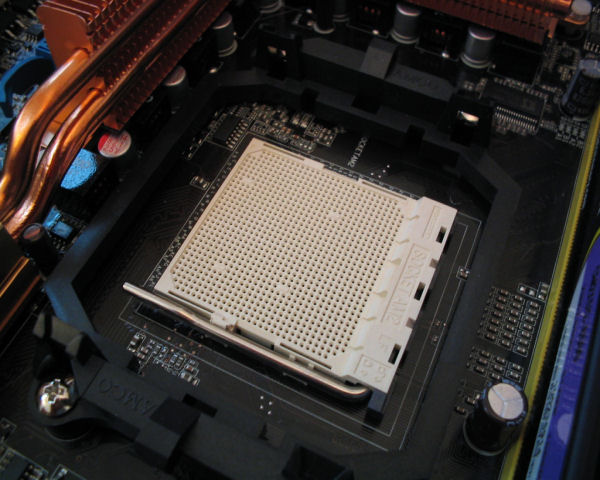
SOCKET AM2 – AN OVERVIEW cont.
Model Numbers
Rather than confusing the consumer with a brand new model numbering scheme most of the model numbers that you are familiar with were brought forward from Socket 939 with their same cache and frequency specifications. However there are some exceptions; Socket AM2 has an X2 4000+ not available in the current 939 family. The FX 62 and X2 5000+ are entirely new models that surpass the previous fastest FX 60 and X2 4800+ processors.
Processor Family & Model Numbers:
- AMD Athlon 64 FX processor: FX-62
- AMD Athlon 64 X2 processors: 5000+, 4800+, 4600+, 4400+, 4200+, 4000+, and 3800+
- AMD Athlon 64 processors: 3800+, 3500+, 3200+
- AMD Sempron processors: 3600+, 3500+, 3400+, 3200+, 3000+, and 2800+
Lower Power Consumption
All the regular X2 processors now have a new, lower maximum power specification of 89 watts (down from 110) for socket AM2. Athlon 64 processors also have a lower max power rating of 62 watts (down from 89). Semprons also have the 62 watt maximum specification. Better still, AMD is offering a line of Energy Efficient processors available on Socket AM2 for the desktop that have maximum wattage specifications of 65 watts and even 35 watts for a small premium over the regular model numbers.
Energy efficient processors deliver the same performance (frequency, cache, etc.) with lower heat and power. Keep in mind that AMD’s specified true maximum power represents consumption under full load at the most extreme conditions and is not comparable to competitors claimed “typical” power consumption numbers which do not represent the most extreme conditions possible.
Energy Efficient models available at 65 Watts max power:
- AMD Athlon 64 X2 processors: 4800+, 4600+, 4400+, 4200+, 4000+, and 3800+
Energy Efficient models available at 35 Watts max power:
- AMD Athlon 64 X2 processor: 3800+
- AMD Athlon 64 processor: 3500+
- AMD Sempron processors: 3400+, 3200+, and 3000+
NOTE: the third digit of a desktop processor’s OPN details the maximum power consumption of that model
- “A” denotes “normal” power
- “O” denotes a 65 watt Energy Efficient processor
- “D” denotes a 35 watt Energy Efficient processor
This empirical reduction in power consumption and heat production will only serve to further enhance the functionality of these new chips. It will also have a domino effect on the support industries and open entirely new avenues for these manufacturers to pursue. Imagine also the huge benefit the 35 watt versions of these processors will provide to those consumers building a new Home Theater PC (HTPC). We could continue with our array of assumptions concerning this element of the new CPU alone, but instead we’ll leave those up to you. Just let your imagination be your guide!
DDR-2 … Why Now?
With the introduction of the socket AM2 processor AMD is the last of the major chipset manufacturers to bite the bullet and change to DDR-2 SDRAM. Why now? That answer is very simple, AMD was waiting until such time that the speeds and latencies of DDR-2 SDRAM were at a point in development to provide their customers with some substantial benefit.
The argument has long been that DDR2 latencies do not match those of DDR, thus DDR is faster. This statement is only true in part. DDR-2 latencies are higher than that of DDR SDRAM. Even though the latencies are higher with DDR-2 (meaning more of a delay in clock cycles) we haven’t considered timing. The new DDR-2 800 MHz for example has a clock cycle timing of around 2.5 nanoseconds as compared to 5 nanosecond timing for the clock cycle on DDR 400 and DDR-2 400.
DDR-2 also operates at 1.8 volts (minimum) as compared to 2.5 volts (minimum) for DDR; meaning less heat and power consumption for DDR2. The resistive termination of DDR-2 is an on-die process as opposed to motherboard regulation on DDR. In layman’s terms this means a cleaner, more stable signal from DDR-2.
We’re in no way attempting to sway your judgment concerning the performance of the two memory types. Just check out the benchmarks later in this review which we think will speak volumes concerning the performance we are seeing from DDR-2 as opposed to its single counterpart. Also remember with AMD’s switch to DDR-2 as a primary memory type for the new socket AM2 the chips are stacked in DDR-2’s favor and we should see similar cycles of advancement to what we experienced with DDR when it was the primary memory type of choice.
SOCKET AM2 – AN OVERVIEW cont.
Preliminary Benchmarks
AMD has suggested that a fair expectation for performance gain from 939-pin to AM2 is about 1% or more across various application-based benchmarks. That assumes equal model numbers for processors and an equal configuration. This also assumes premium memory is used for each configuration. This is a rough estimate, and of course FX-62 and 5000+ come with additional frequency that will improve performance beyond that platform benefit. Below are a handful of raw performance numbers given to us by AMD that were generated on the Asus M2N32-SLI Deluxe motherboard with 1GB of DDR2 800 (4-4-4), a single WD Raptor 10K-RPM hard drive and a single ATI Radeon x1900XTX graphics card. Please use these numbers as a simple guide to know if your testbed is functioning to its full potential.
AMD Athlon 64 FX-62 processor:
- Sysmark 2004SE Office Productivity: 258.3
- Sysmark 2004SE ICC overall: 377.3
- 3DMARK 06 1.02 Overall Hardware: 6,049.7
- 3DMARK 06 Overall Software: 1,216.3
- Unreal Tournament 2004 Flyby (update 3369): 457.2
- Unreal Tournament 2004 Botmatch (update 3369): 168.9
AMD Athlon 64 X2 5000+ processor:
- Sysmark 2004SE Office Productivity: 241.0
- Sysmark 2004SE ICC overall: 348.0
- 3DMARK 06 1.02 Overall Hardware: 5,940.7
- 3DMARK 06 Overall Software: 1,088.7
- Unreal Tournament 2004 Flyby (update 3369): 393.5
- Unreal Tournament 2004 Botmatch (update 3369): 148.4
Pricing
The below stated prices will be AMD’s MSRP on the June 1 launch date:
|
AM2
|
|
|
Processor
|
Price
|
|
FX-62
|
$1,031
|
|
X2 5000+
|
$696
|
|
X2 4800+
|
$645
|
|
X2 4600+
|
$558
|
|
X2 4400+
|
$470
|
|
X2 4200+
|
$365
|
|
X2 4000+
|
$328
|
|
X2 3800+
|
$303
|
|
Athlon 64 3800+
|
$290
|
|
Athlon 64 3500+
|
$189
|
|
Athlon 64 3200+
|
$138
|
|
Sempron 3600+
|
$123
|
|
Sempron 3500+
|
$109
|
|
Sempron 3400+
|
$97
|
|
Sempron 3200+
|
$87
|
|
Sempron 3000+
|
$77
|
|
Sempron 2800+
|
$67
|
|
AM2 PRICING (Energy efficient 65 watt models)
|
|
|
Processor
|
Price
|
|
X2 4800+
|
$671
|
|
X2 4600+
|
$601
|
|
X2 4400+
|
$514
|
|
X2 4200+
|
$417
|
|
X2 4000+
|
$353
|
|
X2 3800+
|
$323
|
|
AM2 PRICING (Energy efficient 35 watt models)
|
|
|
Processor
|
Price
|
|
X2 3800+
|
$364
|
|
Athlon 64 3500+
|
$231
|
|
Sempron 3400+
|
$145
|
|
Sempron 3200+
|
$119
|
|
Sempron 3000+
|
$101
|
SOCKET AM2 X2 5000+ REVIEW
X2 5000+ Specifications
- Frequency / Cache Sizes: 2.6GHz w/ 512KB L2 cache-per-core (1MB total L2 per processor)
- L1 Cache Sizes: 64K- L1 instruction + 64K – L1 data cache per core (256KB total L1)
- CPU to Memory Controller: same as CPU core frequencies
- Memory Controller: Shared integrated 128-bit wide memory controller
- DDR2 Memory Supported: Up to and including PC2 6400 (800MHz) DDR-2 memory
- HyperTransport Spec: 2GHz (2x 1000MHz / DDR)
- Effective data bandwidth: 20.8 GB/sec [8GB/sec HyperTransport link + 12.8GB/sec memory]
- Process Technology: 90nm (.09-micron) Silicon on Insulator (SOI)
- Approximate Transistor count: 153.8 million
- Approximate Die Size: 183mm2
- Nominal Voltage: 1.30-1.35V
- Max Thermal Power: 89 W
- Max Ambient Case Temp: 55-70 degrees Celsius
- Max Icc (processor current): 66.2A
- Min P-State (with C’n’Q): 1.0 GHz
- Nominal Voltage @ min -state: 1.1V
- Max Thermal Power @ min -state: 31.0W
- Max Icc @ min -state: 25.5A
AMD AM2 5000+ Test System
- AMD X2 5000+ Socket AM2
- Asus M2N32-SLI Deluxe nForce 590
- 1GB kit of Corsair DDR 2 8500
- 2 x NVIDIA 7800GTX 512MB in SLI and Single
- 2 x Seagate 7200.10 750GB in RAID1
- SB X-FI Platinum
- PC Power and Cooling 1KWatt SLI Power Supply
- Lian-Li V1200 Case
- Windows XP Pro SP2
- Dell 20″ LCD
- ForceWare 81.98 and DirectX 9.0c
AMD Athlon 64 FX Test System
- Asus A8N32-SLI Deluxe
- AMD Athlon 64 FX-60 (and FX-55 for SLI tests)
- 2GB Corsair 3500LL PRO
- 3 x 250GB Maxtor Diamond 10 in RAID 5
- PC Power & Cooling 1kW PSU
- Creative X-Fi Platinum Sound Card
- 2 x Reference 7800 GTX 512
- Windows XP SP2
- ForceWare 81.98 and DirectX 9.0c
Intel Pentium 4/D Test System
- Gigabyte 955X Royal
- Intel Pentium 4 670 (3.8GHz) and Pentium D 840 (3.2GHz dual-core)
- 1GB Corsair 5400UL DDR2
- 74GB Western Digital Raptor
- Enermax PSU
- XFX 7800 GTX 512 XXX (clocked to match reference)
- Windows XP SP2
- ForceWare 81.98 and DirectX 9.0c
Benchmarks
- Futuremark PCMark05
- SiSoftware Sandra 2005 – CPU Arithmetic, CPU Multimedia and Memory Bandwidth
- Super PI – 32M
- Futuremark 3DMark05
- Counter-Strike: Source
- F.E.A.R.
- Quake 4
Testing Methodology
We will run the above captioned benchmarks on all three systems with the each system at default speed. For all game testing, image quality was set to “Quality” in the NVIDIA driver control panel, and antialiasing and anisotropic filtering were both set to “application control.” SLI testing will performed on each each system at the standard 1600 x 1200 resolution with no Anti-Aliasing (AA) and no Anisotropic Filtering (AF). The SLI benchmarks will be repeated again using the standard resolution 1600 x 1200 coupled with an AA values of 4 and an AF value of 8.
TEST RESULTS – SYSTEM
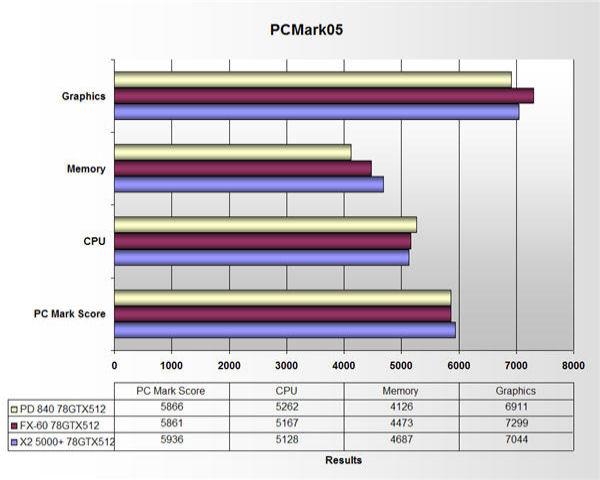
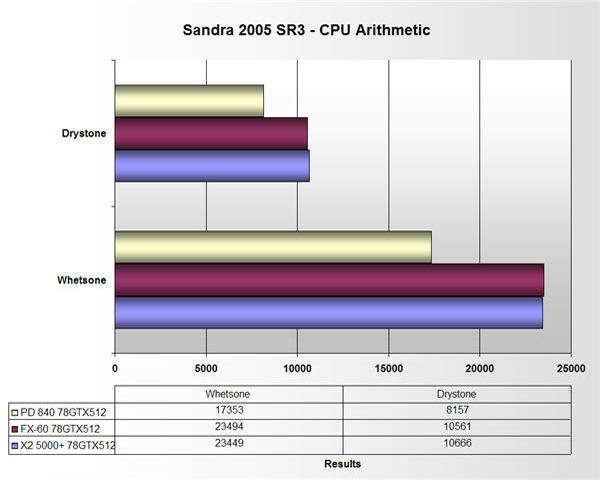
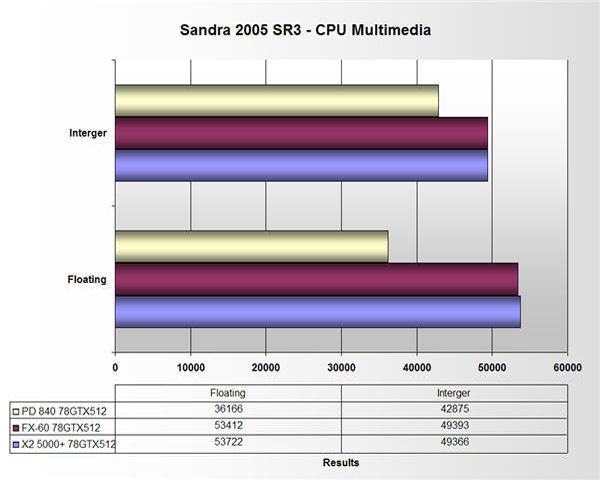
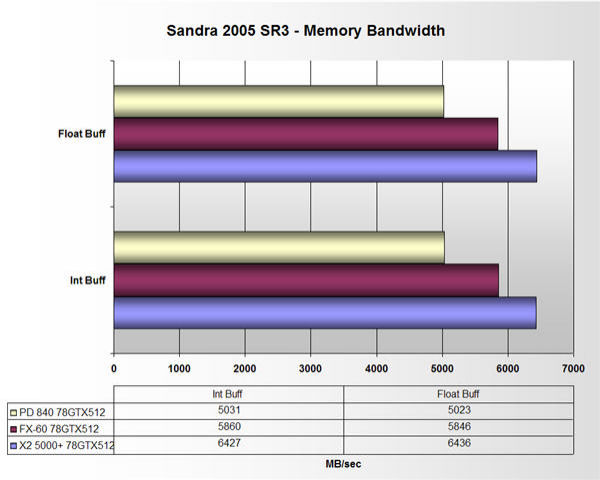
TEST RESULTS – GAMING
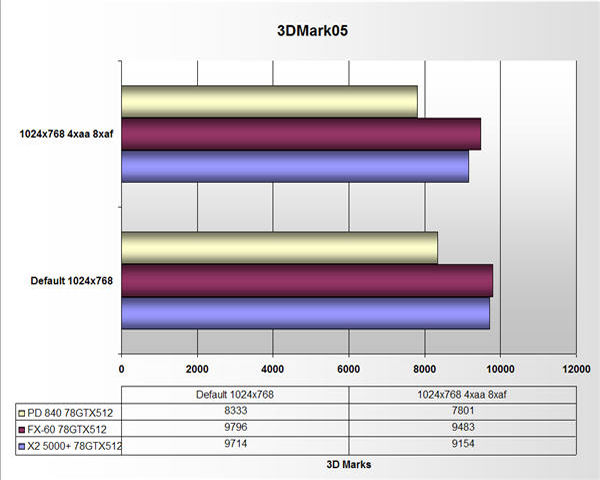
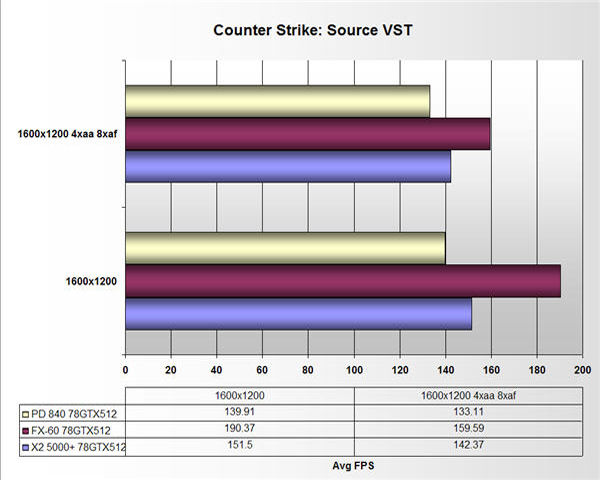

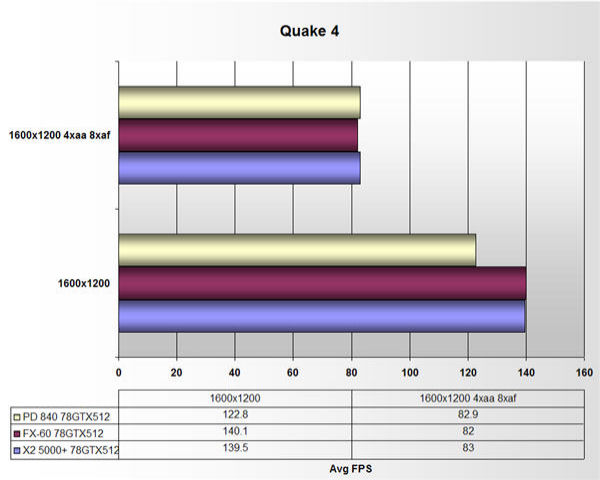
TEST RESULTS – SLI & IMPRESSION
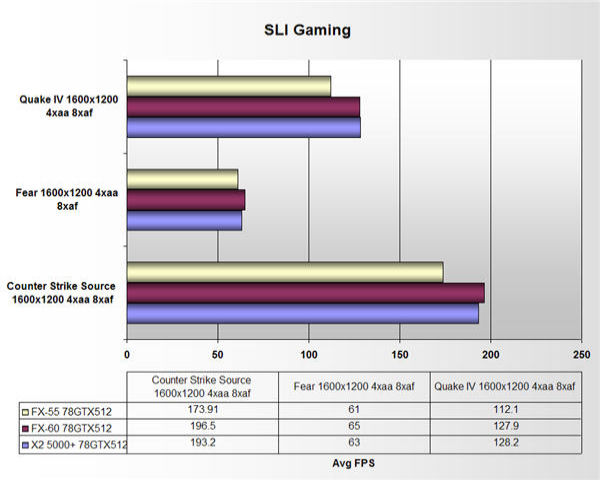
Impression
At first glance you will notice that the X2 5000+ essentially dominates all of the benchmarks that are memory related. We asked the question earlier: Why DDR-2? We alluded to the answer being the additional bandwidth that DDR-2 provides. The facts now speak for themselves. Also consider that in the test system for the X2 5000+ we are only running 1 Gig of DDR-2 as opposed to 2 Gigs of premium low latency DDR in both of the other test systems. AMAZING! We certainly believe so.
As far as the gaming benchmarks are concerned you may be saying to yourself that the FX-60 is a clear winner, and you would be right. Remember though we’re not comparing apples to apples here! The X2 5000+ is not the FX-62; nor is it a completely fair comparison to the FX-60. We say this even though both chips are running at 2.6GHz, the FX 60 has 1 Meg per core as opposed to only 512 Kb per core for the X2 5000+. Also remember that the test system for the X2 5000+ is totally new from head to toe. This means an early BIOS release for the motherboard as well. We feel it safe to say that in a very short time the differences between the two processors will be negligible if at all.
CONCLUSION
AMD has done what we feel to be an outstanding job with the introduction of their socket AM2 lineup. The X2 5000+ we reviewed today completely surprised us from the standpoint of how well it performs, particularly in the realm of memory related benchmarks. We forgot to mention earlier that the X2 5000+ in our test system performed as much as 6-7 degrees Celcius cooler than its FX-60 opponent. This is an 89 watt processor, not the low energy 65 watt version that will be available in the socket AM2 series up through the X2 4800+.
At launch AMD’s MSRP for the X2 5000+ is $696.00 USD. While we wish it could have been lower we feel it’s priced competitively with other high-end CPUs in the same category of performance.
If we had to bet we’d say the next year for the Computer Enthusiast will be one of the most exciting yet. AMD has laid down the gauntlet with their new socket AM2 series of processors. Rumors and leaked test results of what the competition will counter with are already surfacing. Benchmarking shoot-outs for bragging rights will obviously be forthcoming. Who will be the clear cut winner? We have no crystal ball but think it’s safe to say that we the, Computer Enthusiasts will; as competition of this type will only serve to bring better, faster, and more resilient products to the market.
Pros:
+ Excellent utilization of DDR-2 SDRAM
+ Decreased memory power consumption and heat production
+ Extremely fast and reliable
+ In-chip virtualization support
+ Decreased CPU core voltage and heat production
Cons:
– Expensive (as are all high-end CPUs)
<Final Score: 9.5 out of 10, and and our highest award, the Golden Bear Award
 Bjorn3D.com Bjorn3d.com – Satisfying Your Daily Tech Cravings Since 1996
Bjorn3D.com Bjorn3d.com – Satisfying Your Daily Tech Cravings Since 1996



